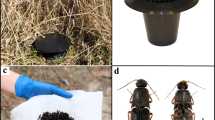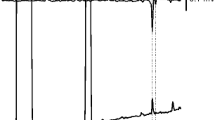Abstract
A male-produced pheromone that attracts both males and females was identified for the European woodwasp, Sirex noctilio, a serious pest of pine trees. Males displayed excitatory behaviors when placed in groups, and were attracted to the odors from males that were 2-5-d-old, but not to odors from males that were 0-1-d-old. An unsaturated short-chain alcohol, (Z)-3-decen-1-ol, was discovered in samples collected on SuperQ filters over groups of males and identified by using micro-derivatization reactions and gas chromatography coupled with mass spectrometry (GC-MS). The compound was not detected in volatile samples from females. Gas chromatography coupled electroantennographic detection (GC-EAD) of antennae from males exposed to male headspace odors produced strong antennal responses to the main peak of (Z)-3-decen-1-ol, as well as to an unknown minor component that had a similar retention time. Antennae from both males and females responded to synthetic (Z)-3-decen-1-ol. Several different synthetic candidates for the GC-EAD active minor components were selected based on GC-MS and GC-EAD responses to male headspace collections. These synthetic compounds were tested for antennal activity using GC-EAD, and those that produced strong responses were blended with the major component and tested for male attraction in the Y-tube olfactometer at different concentrations and ratios. Males tested in the Y-tube olfactometer were attracted to a synthetic blend of (Z)-3-decen-1-ol and (Z)-4-decen-1-ol at a ratio of 100:1. Whereas the addition of some suspected minor compounds reduced attraction, the addition of a third compound found in male emanations that produced strong male antennal responses, (E,E)-2,4-decadienal (at a ratio of 100:1:1), resulted in attraction of both males (Y-tube and wind tunnel) and females (wind tunnel).





Similar content being viewed by others
References
Aldrich, J. R., Oliver, J. E., Shifflet, T., Smith, C. L., and Dively, G. P. 2007. Semiochemical investigations of the insidious flower bug, Orius insidiosus (Say). J. Chem. Ecol. 33:1477–143.
Böröczky, K., Crook, D. J., Jones, T. H., Kenny, J. C., Zylstra, K. E., Mastro, V. C., and Tumlinson, J. H. 2009. Monoalkenes as contact sex pheromone components of the woodwasp Sirex noctilio. J. Chem. Ecol. 35:1202–1211.
Brown, C. A. and Ahuja, V. K. 1973. “P-2 nickel” catalyst with ethylenediamine, a novel system for highly stereospecific reduction of alkynes to cis-olefins. J. Chem. Soc. Chem. Comm.:553–554.
Butenandt, A., Beckmann, R., Stamm, D., and Hecker, E. 1959. Über den sexual-lockstoff des seidenspinners Bombyx mori. Z. Naturforsch. 14b:283.
Carnegie, A. J., Matsuki, M., Haugen, D. A., Hurley, B. P., Ahumada, R., Klasmer, P., Sun, J., and Iede, E. T. 2006. Predicting the potential distribution of Sirex noctilio (Hymenoptera: Siricidae), a significant exotic pest of Pinus plantations. Ann. For. Sci. 63:119–128.
Ciesla, W. M. 2003. European woodwasp: A potential threat to North America’s conifer forests. J. For. 101:18–23.
Collett, N. G. and Elms, S. 2009. The control of Sirex wood wasp using biological control agents in Victoria, Australia. Ag. For. Entomol. 11:283–294.
Consoli, F. L., Williams, H. J., Vinson, S. B., Matthews, R. W., and Cooperband, M. F. 2002. trans-Bergamotenes—male pheromone of the ectoparasitoid Melittobia digitata. J. Chem. Ecol. 28:1675–1689.
Cooperband, M. F., McElfresh, J. S., Millar, J. G., and Cardé, R. T. 2008. Attraction of female Culex quinquefasciatus Say (Diptera: Culicidae) to odors from chicken feces. J. Insect Physiol. 54:1184–1192.
Cossé, A. A., Bartelt, R. J., Weaver, D. K., and Zilkowski, B. W. 2002. Pheromone components of the wheat stem sawfly: identification, electrophysiology, and field bioassay. J. Chem. Ecol. 28:407–423.
CouTts, M. P. 1965. Sirex noctilio and the physiology of Pinus radiata. Some studies of interactions between the insect, the fungus, and the tree in Tasmania. Forestry and Timber Bureau, Australia Bulletin. 79 pp.
Gilmour, J. W. 1965. The life cycle of the fungal symbiont of Sirex noctilio. N. Z. J. For. Sci. 10:80–89.
Ho, H.-Y., Kou, R., and Tseng, H.-K. 2003. Semiochemicals from the predatory sting bug Eocanthecona furcellata (Wolff): Components of metathoracic gland, dorsal abdominal gland, and sternal gland secretions. J. Chem. Ecol. 29:2101–2114.
Hoebeke, E. R., Haugen, D. A., and Haack, R. A. 2005. Sirex noctilio: Discovery of a palearctic siricid woodwasp in New York. News. Mich. Entomol. Soc. 50:24–25.
Jewett, D., Matsumura, F., and Coppel, H. C. 1978. Preparation and use of sex attractants for four species of pine sawflies. J. Chem. Ecol. 4:277–287.
Kaiser, R. 1993. The Scent of Orchids: Olfactory and Chemical Investigations. Basel, Switzerland: Editiones Roche.
Kovats, E. S. 1965. Gas chromatographic characterization of organic substances in the retention index system. pp 229–247, in J. C. Giddings and R. A. Keller (eds.). Advances in chromatography. New York: Marcel Dekker, Inc.
Leal, W. S., Moura, J. I. L., Bento, J. M. S., Vilela, E. F., and Pereira, P. B. 1997. Electrophysiological and behavioral evidence for a sex pheromone in the wasp Bephratelloides pomorum. J. Chem. Ecol. 23:1281–1289.
Madden, J. L. 1974. Oviposition behaviour of the woodwasp, Sirex noctilio F. Aust. J. Zool. 22:341–351.
Madden, J. L. 1982. Avian predation of the woodwasp Sirex noctilio F., and its parasitoid complex in Tasmania. Aust. Wildl. Res. 9:135–144.
Madden, J. L. 1988. Sirex in Australia. In: Berryman AA, ed. Dynamics of Forest Insect Populations. New York: Plenum.
Marshall, L. D. and Alcock, J. 1981. The evolution of the mating system of the Carpenter bee Xylocopa varipuncta (Hymenoptera: Anthophoridae). J. Zool. 193:315–324.
Morgan, D. and Stewart, N. C. 1966. The biology and behaviour of the woodwasp Sirex noctilio F. in New Zealand. Tran. Roy. Soc. N. Z., Zool. 7:195–204.
Pompanon, F., De Schepper, B., Mourer, Y., Fouillet, P., and Bouletreau, M. 1997. Evidence for a substrate-borne sex pheromone in the parasitoid wasp Trichogramma brassicae. J. Chem. Ecol. 23:1349–1360.
Rawlings, G. B. 1953. Rearing of Sirex noctilio and its parasite Ibalia leucospoides. N. Z. For. Res. Notes 1:20–34.
Ray, A. M., Millar, J. G., McElfresh, J. S., Swift, I. P., Barbour, J. D., and Hanks, L. M. 2009. Male-produced aggregation pheromone of the cerambycid beetle Rosalia funebris. J. Chem. Ecol. 35:96–103.
Robacker, D. C. and Hendry, L. B. 1977. Neral and geranial: components of the sex pheromone of the parasitic wasp, Itoplectis conquisitor. J. Chem. Ecol. 3:563–577.
Schulmeister, S. 2001. Functional morphology of the male genitalia and copulation in lower Hymenoptera, with special emphasis on the Tenthredinoidea s. str. (Insecta, Hymenoptera, ‘Symphyta’). Acta Zool. (Stockh.) 82:331–349.
Schulmeister, S. 2003. Genitalia and terminal abdominal segments of male basal Hymenoptera (Insecta): morphology and evolution. Org. Divers. Evol. 3:253–279.
Simpson, R. F. 1976. Bioassay of pine oil components as attractants for Sirex noctilio (Hymenoptera: Siricidae) using electroantennogram techniques. Entomol. Exp. Appl. 19:11–18.
Simpson, R. F. and McQuilkin, R. M. 1976. Identification of volatiles from felled Pinus radiata and the electroantennograms they elicit from Sirex noctilio. Entomol. Exp. Appl. 19:205–213.
Slippers, B., Coutinho, T. A., Wingfield, B. D., and Wingfield, M. J. 2003. A review of the genus Amylostereum and its association with woodwasps. S. Afr. J. Sci. 99:70–74.
Smith, D. R. and Schiff, N. M. 2002. A review of the siricid woodwasps and their ibaliid parasitoids (Hymenoptera: Siricidae, Ibaliidae) in the eastern United States, with emphasis on the mid-Atlantic region. Proc. Entomol. Soc. Wash. 104:174–194.
Sokal, R. R. and Rohlf, J. F. 1995. Biometry. New York, NY: W. H. Freeman and Company.
Van Den Dool, I. and Kratz, P. D. 1963. A generalization of the retention index system including linear temperature programmed gas-liquid partition chromatography. J. Chromatogr. 2:463–471.
Vinson, S. B. 1972. Courtship behavior and evidence for a sex pheromone in the parasitoid Campoletis sonorensis (Hymenoptera: Ichneumonidae). Environ. Entomol. 1:409–414.
Yoshida, S. 1978. Behaviour of males in relation to the female sex pheromone in the parasitoid wasp, Anisopteromalus calandrae (Hymenoptera: Pteromalidae) Entomol. Exp. Appl. 23:152–162.
Zondag, R. 1969. A nematode infection of Sirex noctilio (F.) in New Zealand. N. Z. J. Sci. 12:732–747.
Zylstra, K. E., Dodds, K. J., Francese, J. A., and Mastro, V. 2010. Sirex noctilio in North America: the effect of stem-injection timing on the attractiveness and suitability of trap trees. Ag. For. Entomol. 12:243–250.
Acknowledgements
We thank Michael Crawford for his help in providing infested wood and adult Sirex for this study. We are thankful to Jocelyn Millar, Ashot Khrimian, and Allard Cossé for assistance and discussions on chemistry. We thank Daniel Lafoon, Hanna Wingard, Sian Bailey, and Nate McCartney for technical help. We thank Damon Crook, Sandy Allan, Juli Gould, Meg Allen, Joe Francese, and Mike Stefan for comments on the manuscript. Mention of a commercial product does not constitute an endorsement or recommendation for its use by USDA.
Author information
Authors and Affiliations
Corresponding author
Rights and permissions
About this article
Cite this article
Cooperband, M.F., Böröczky, K., Hartness, A. et al. Male-Produced Pheromone in the European Woodwasp, Sirex noctilio . J Chem Ecol 38, 52–62 (2012). https://doi.org/10.1007/s10886-012-0060-7
Received:
Revised:
Accepted:
Published:
Issue Date:
DOI: https://doi.org/10.1007/s10886-012-0060-7




